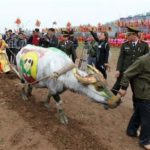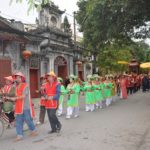Never empty of visitors, Duong Lam Ancient Village in Son Tay Town on the outskirts of Hanoi is a well-known destination for Hanoi people. The charm of the century-old houses and winding alleys, combined with the ancient vibes, cozy atmosphere, and excellent cuisine, make it a favorite spot for families to bring their children.
| Visitors to the ancient village of Duong Lam in Hanoi. Photo: Huy Pham |
Roast Pork: Thit quay gion
Famous for its elaborate recipe, roast pork on a stick or thit quay gion can take up to six hours to make. Duong Lam cooks start by selecting fresh belly pork with thick skin but not too much fat. The pork is then marinated in spices, pepper, fresh shallots, and a special Vietnamese spice mixture called “hung liu” or guava leaves.
The guava leaves are a key ingredient that gives the dish its distinct flavor. Only young guava leaves are carefully picked, chopped, and mixed with the pork for about an hour. More mature but not dry leaves are then stuffed into the pieces of pork before roasting. The soaked pork is rolled up and wrapped around bamboo sticks with banana leaves in between.
| Thit quay gion or roast pork on a stick – a specialty of Duong Lam Ancient Village. Photo: Ha Hai |
The roasting process has its own standards. The pieces of pork are initially placed about 50 cm above the fire. As the meat becomes firmer, the distance is reduced to about 30 cm. The cook must carefully maintain the proper distance and let the pork cook slowly. When the pork tightens and the fat drains off, the sticks are lowered to give it a striking color.
A successfully roasted piece of belly pork should have a crispy and puffy skin, which makes a popping sound when pierced with a bamboo skewer. To enhance its fragrance and flavor, the meat is also coated with a thin layer of honey.
Steamed Sugarcane Chicken: Ga Mia hap
In Duong Lam, there is a breed of chicken called Ga Mia or Sugarcane Chicken, named after the old name of the village. In the past, these chickens were considered a delicacy, offered only to royalty or on special occasions to symbolize prosperity.
| The dish of Ga Mia hap or steamed Sugarcane Chicken. |
Raised on a diet of corn, cassava, and rough rice, these chickens weigh only about two kilos, but their meat is very firm. Today, these valuable chickens are raised and served to tourists visiting the ancient village. Ga Mia is often steamed to preserve its strong, savory flavor. It is recommended to let it cool before enjoying to fully appreciate its sweetness and aroma.
Nutty Ginger Sticky Rice Bars: Che lam
In the suburbs of Hanoi, many places make che lam or nutty ginger sticky rice bars, but the ones made by the people of Duong Lam Ancient Village stand out with their distinctive flavor. Che lam here is chewy and has the aroma of toasted glutinous rice flour and ginger, combined with the sweetness of molasses and malt.
Visitors can have a tour of the century-old houses where the production facilities are located, and witness the process of making che lam first hand. Additionally, food stalls around the village often feature female vendors who display the sweet in large chunks on a tray and cut it fresh to order.
| The dish of che lam. Photo: Xuan Minh |
Che lam is also sold alongside childhood sweets such as peanut candy or sausage candy, which add to the rustic snacks with rural flavors in Duong Lam.
While exploring Duong Lam, visitors should also try traditional leaf-wrapped cakes like banh te, banh nep, banh gai, banh gio, or banh duc.
Fermented Soybean Paste: Tuong nep
Throughout the village streets and houses, tourists can easily find large yards filled with clay jars. These jars are used to make tuong nep or fermented soybean paste, a traditional craft that has been passed down for hundreds of years. Duong Lam’s tuong nep has an unforgettable sweet and buttery taste that sets it apart from others. This paste enhances the flavors of many dishes in the old village, such as boiled morning glory, buffalo meat, or beef.
| Making tuong nep or fermented soybean paste. |
Visitors have the opportunity to buy the fermented soybean paste from traditional shops in the village. The price of a 500ml bottle usually ranges from VND20,000 to VND35,000 (approximately $0.8 to $1.5). Some well-known shops include Mrs. Mien’s in Phu Khang hamlet, Mrs. Son Thach’s, Mr. Ly Da’s, and Mr. Liem’s in Mong Phu hamlet, or Mrs. Tu Lam’s in Dong Sang hamlet.
While some specialty shops in Duong Lam have modern production lines, many local dishes still require manual preparation to achieve the desired quality. Therefore, if you want to taste delicacies like thit quay gion, ga mia hap, tuong nep, or leaf-wrapped cakes, it is recommended to visit any restaurant in the village.
There are some restaurants in the village that offer not only delicious food but also an old, nostalgic atmosphere, such as Mrs. Dien’s Old House at No. 19, Mong Phu Hamlet, Mr. Hung’s Old House, and Bep Lang Duong Lam.
|
Tips for Bringing Small Children to Duong Lam Ancient Village Based on the experiences of families, winter and spring are the ideal times to bring children to Duong Lam Ancient Village. The village is approximately a 40 to 50-minute drive, covering a distance of 35 km, from downtown Hanoi. Travelers can choose to go down Thang Long Avenue or take the Cau Giay-Ho Tung Mau-National Highway 32 route. Visitors are advised to wear comfortable clothes and shoes or sandals suitable for walking or biking around the village. It is recommended to hire a tour guide to fully understand the history and significance of each street, ancient house wall, or ancient relic closely related to the lives of the villagers. The entrance fee to the ancient village is VND20,000 or approximately $0.8 per adult. Bicycle rental is also available at VND50,000 or $2 per bike for the whole day. |
Ha Long Carnival opens in Quang Ninh
The Ha Long Carnival, a highlight of the Ha Long – Quang Ninh tourism week 2019, opened in Bai Chay and Hon Gai tourism area in the northern province of Quang Ninh on April 28.













